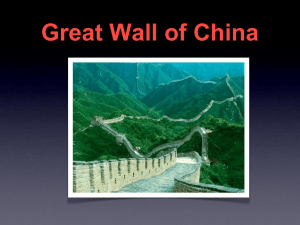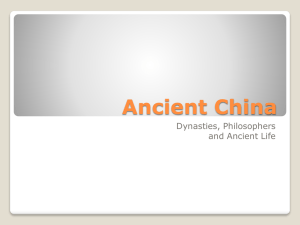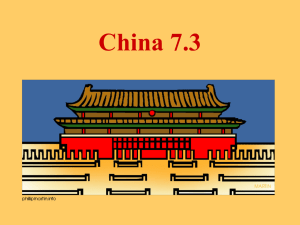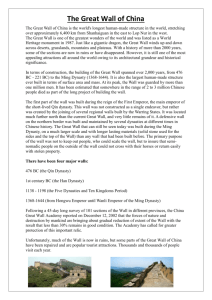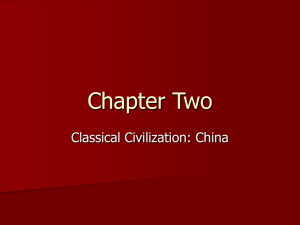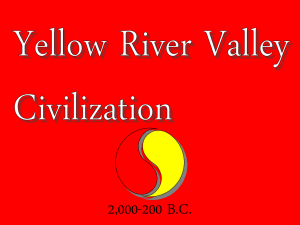Book Notes for Unit 3 Ch 3 China
advertisement
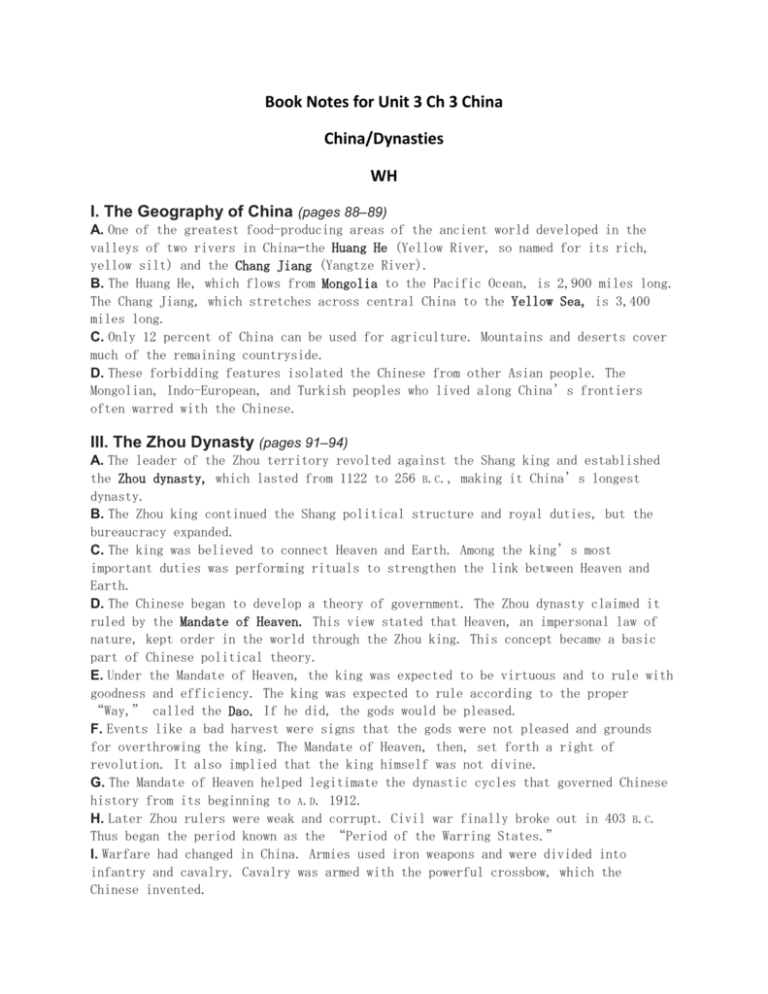
Book Notes for Unit 3 Ch 3 China China/Dynasties WH I. The Geography of China (pages 88–89) A. One of the greatest food-producing areas of the ancient world developed in the valleys of two rivers in China—the Huang He (Yellow River, so named for its rich, yellow silt) and the Chang Jiang (Yangtze River). B. The Huang He, which flows from Mongolia to the Pacific Ocean, is 2,900 miles long. The Chang Jiang, which stretches across central China to the Yellow Sea, is 3,400 miles long. C. Only 12 percent of China can be used for agriculture. Mountains and deserts cover much of the remaining countryside. D. These forbidding features isolated the Chinese from other Asian people. The Mongolian, Indo-European, and Turkish peoples who lived along China’s frontiers often warred with the Chinese. III. The Zhou Dynasty (pages 91–94) A. The leader of the Zhou territory revolted against the Shang king and established the Zhou dynasty, which lasted from 1122 to 256 B.C., making it China’s longest dynasty. B. The Zhou king continued the Shang political structure and royal duties, but the bureaucracy expanded. C. The king was believed to connect Heaven and Earth. Among the king’s most important duties was performing rituals to strengthen the link between Heaven and Earth. D. The Chinese began to develop a theory of government. The Zhou dynasty claimed it ruled by the Mandate of Heaven. This view stated that Heaven, an impersonal law of nature, kept order in the world through the Zhou king. This concept became a basic part of Chinese political theory. E. Under the Mandate of Heaven, the king was expected to be virtuous and to rule with goodness and efficiency. The king was expected to rule according to the proper “Way,” called the Dao. If he did, the gods would be pleased. F. Events like a bad harvest were signs that the gods were not pleased and grounds for overthrowing the king. The Mandate of Heaven, then, set forth a right of revolution. It also implied that the king himself was not divine. G. The Mandate of Heaven helped legitimate the dynastic cycles that governed Chinese history from its beginning to A.D. 1912. H. Later Zhou rulers were weak and corrupt. Civil war finally broke out in 403 B.C. Thus began the period known as the “Period of the Warring States.” I. Warfare had changed in China. Armies used iron weapons and were divided into infantry and cavalry. Cavalry was armed with the powerful crossbow, which the Chinese invented. J. Peasants worked on land owned by the aristocracy, along with a little land of their own. Artisans and merchants lived in walled towns. The merchants were the local lord’s property. Slaves also existed. Trade was principally local, along with importing salt, cloth, iron, and luxury goods. K. By the sixth century B.C., farmers were using large-scale water works for their fields. Using iron plowshares increased food production because farmers could cultivate more land. The Chinese population reached fifty million people in the late Zhou dynasty, in part due to the increased food production. L. Silk was one of China’s most important exports. Chinese silk from this period has been found all over central Asia and as far as Athens, Greece. M. The Chinese had, and have, strong beliefs about the family. It was both the basic economic unit and a symbol of the social order. Most important to Chinese family life is the concept of filial piety. N. Filial piety refers to the duty of family members to subordinate their needs to the male head of the family and the older generations. It is an important Confucian concept. O. Men dominated Chinese society. Men were considered so important because they were responsible for providing food for the family and caring for their patents later in life. Men governed society, and were warriors and scholars. Women raised children and stayed at home. P. Perhaps the most important cultural contribution of ancient China is the Chinese written language. It was primarily pictographic and ideographic. Q. Pictographs are picture symbols, called characters. Ideographs combine two or more pictographs. Each character is associated with a sound. Generally, this step leads cultures to replace character writing with phonetic (sound) writing. The Chinese language, however, has not completely abandoned its original form. I. The Qin Dynasty (221–206 B.C.) (pages 98–100) A. The Qin dynasty emerged in 221 B.C. from China’s bloody civil wars between 400 B.C. and 200 B.C. Qin Shihuangdi established the dynasty. B. The Qin dynasty adopted Legalism. Political opponents of the regime (the government in power) were imprisoned or executed. Books that opposed the official views were burned. The Qin made the central government stronger. The government was divided into three ministries: the civil, the military, and the censorate. Members of the censorate checked on government officials to make sure they were doing their jobs. Future Chinese dynasties adopted this practice and kept this structure. C. Qin Shihuangdi unified the Chinese world by creating a monetary system and a road system. He extended the empire south to modern-day Vietnam. The harsh rule of the Qin dynasty angered many people. The dynasty fell in 206 B.C. D. The Qin emperor was concerned with the Xiongnu, a nomadic people who lived near the Gobi. The Xiongnu had mastered warfare from horseback. They attacked the Chinese living in the north. To protect these people, Qin Shihuangdi built a system of walls called the Great Wall of China. The Great Wall standing today was built 1,500 years later. II. The Han Dynasty (202 B.C–A.D. 220) and Culture in Qin and Han China (pages 100–103) A. The Han dynasty was one of China’s greatest dynasties. It emerged in 202 B.C. and was founded by Liu Bang, who was of peasant origin. He replaced Legalism with Confucianism. He kept the division of the central government into three ministries and the division of the empire into provinces. B. The Han rulers continued to choose government officials by merit and not birth. The Han instituted the civil service examination and established schools to train candidates for government service. This system for training officials influenced China for two thousand years. Students learned Confucius’s teachings, Chinese history, and Chinese law. Han Wudi added land to the south to the empire, as far as the South China Sea, in what is today northern Vietnam. C. The free peasants suffered during the Han period. Military service and a month’s forced labor each year were required. The tripling of the population shrank the size of the individual farm plot to about one acre a person—barely enough to survive. Free farmers became tenant farmers. D. Technology progressed under the Han. There were advances in textile manufacturing, water mills, and iron casting, the latter leading to the invention of steel. The invention of the rudder and fore-and-aft rigging made sailing into the wind possible for the first time. Chinese traders were able to sail into the Indian Ocean, expanding trade tremendously. E. Paper was developed in the Han period. F. Over time, Han rulers too involved with pleasure weakened the government. The aristocratic families filled the power void, often corruptly and brutally. Peasant revolts became common. The Han dynasty fell in A.D. 220. Civil wars followed, and the next dynasty was not established for four hundred years. G. The Qin and Han dynasties were known for their cultural achievements. The key Confucian works were printed in a set. Generations of Chinese schoolchildren learned the norms of proper behavior from these texts. H. The most remarkable artistic discovery was of a burial pit containing thousands of life-size, lifelike, terra-cotta (hardened clay) soldiers. Archaeologists believe they are replicas of Qin Shihuangdi’s imperial guard accompanying him to the next world. Their most striking feature is the individuality of the faces, which reflect the different ethnic types in the army.



